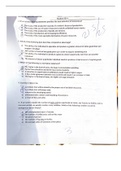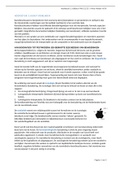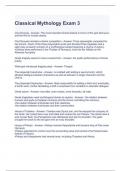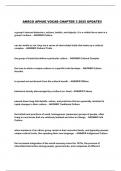Prof. Dr. F. Van Den Spiegel
Pauline Delphine A Verhelst
VUB | 2021-2022
,TABLE OF CONTENTS
INTRODUCTION .............................................................................................................................................. 3
CHAPTER 1 – THE FINANCIAL SYSTEM AND THE ROLE OF BANKS ..................................................................... 5
1.1. A BRIEF HISTORY ......................................................................................................................................... 5
1.2. WHAT IS A BANK? ....................................................................................................................................... 7
1.3. THE SPECIFIC ROLE OF CENTRAL BANKS ............................................................................................................ 7
1.4. THE ROLE OF COMMERCIAL BANKS AS TRANSMISSION MECHANISM OF MONETARY POLICY ........................................ 10
1.5. THE CONCEPT OF “FRACTIONAL BANKING” AND MONEY CREATION BY BANKS ......................................................... 10
1.6. THE ACTUAL CHALLENGES OF THE FINANCIAL SYSTEM ........................................................................................ 11
1.7. WHY FINANCIAL INTERMEDIATION IS NEEDED AND HOW IT CAN BE ORGANIZED ...................................................... 15
1.8. WHY ANY FINANCIAL SYSTEM IS POTENTIALLY UNSTABLE ................................................................................... 20
1.9. BANKS TRANSFORM FINANCIAL FLOWS, WHICH INCREASES RISKS ......................................................................... 20
1.10. BANKS AND INFORMATION ECONOMICS ......................................................................................................... 20
1.11. BANKING PRODUCTS AND SERVICES............................................................................................................... 21
1.12. TYPES OF BANKS ....................................................................................................................................... 21
CHAPTER 2 – ORIGIN AND CONSEQUENCES OF THE FINANCIAL CRISIS OF 2007 ............................................. 23
2.1. THE EXTRAORDINARY ENVIRONMENT SINCE 1990 ........................................................................................... 23
2.2. WEAKNESSES OF THE FINANCIAL SYSTEM........................................................................................................ 30
2.2.1. Dangerous strategies of banks .................................................................................................... 30
2.2.2. Increasing complexity/opaqueness of innovative products ........................................................ 31
2.3. THE CRISIS STARTED 2007 .......................................................................................................................... 35
2.4. THE (EU) BANKING SECTOR TODAY ............................................................................................................... 36
CHAPTER 3 – THE NEW REGULATORY FRAMEWORK FOR BANKS ................................................................... 40
3.1. THE BUILDING BLOCKS OF FINANCIAL REGULATION/ SUPERVISION........................................................................ 40
3.1.1. Micro-prudential regulation/supervision .................................................................................... 41
3.1.1.1. Focus on the soundness of the individual bank ...................................................................................... 41
3.1.1.2. History of BASEL regulation .................................................................................................................... 42
3.1.2. Focus on market conduct ............................................................................................................ 47
3.1.3. Focus on lender of last resort ...................................................................................................... 48
3.1.4. Deposit guarantee scheme .......................................................................................................... 49
3.1.5. Focus on macro-prudential regulation/ supervision.................................................................... 49
3.1.6. Focus on crisis management ....................................................................................................... 50
3.1.7. Other important aspects ............................................................................................................. 52
3.1.7.1. Structural reform .................................................................................................................................... 52
3.1.7.2. SIFI ........................................................................................................................................................... 52
3.1.7.3. Banking union in the EU .......................................................................................................................... 53
3.2. SITUATION OF BANKS TODAY ....................................................................................................................... 54
3.2.1. Profitability = major problem ...................................................................................................... 55
3.2.2. Liquidity ....................................................................................................................................... 58
3.2.3. Sum of all the impact .................................................................................................................. 58
3.2.4. Impact of new regulation on bank profitability........................................................................... 60
CHAPTER 4 – BANK BALANCE SHEET AND INCOME MANAGEMENT ............................................................... 61
4.1. BANKS VERSUS OTHER COMPANIES ............................................................................................................... 61
4.2. BANKS’ BALANCE SHEET AND INCOME STRUCTURE ........................................................................................... 62
4.2.1. General introduction ................................................................................................................... 62
4.2.2. A typical retail bank .................................................................................................................... 63
4.2.3. A typical investment bank ........................................................................................................... 63
4.3. BANKING RISK TYPES AND MANAGEMENT: THE PRICE TO PAY FOR RETURN ............................................................ 64
4.3.1. Credit risk .................................................................................................................................... 64
4.3.2. Liquidity risk ................................................................................................................................ 66
4.3.3. Interest rate risk .......................................................................................................................... 67
4.3.4. Currency risk ................................................................................................................................ 69
4.3.5. Operational risk ........................................................................................................................... 70
1
, 4.3.6. Leverage/ solvency risk ............................................................................................................... 70
4.3.7. Rating risk ................................................................................................................................... 70
4.3.8. All the other usual business risks ................................................................................................. 71
4.4. RISK VERSUS PROFITABILITY ......................................................................................................................... 71
4.5. CAMELS ................................................................................................................................................ 71
CHAPTER 5 – INTERNATIONAL BANKING ....................................................................................................... 72
5.1. THE NEED FOR AN INTERNATIONAL APPROACH OF THE FINANCIAL SYSTEM ............................................................. 72
5.2. WHY BANKS BECOME INTERNATIONAL ........................................................................................................... 75
5.3. THE SPECIFICITY OF THE EU FINANCIAL SYSTEM ............................................................................................... 76
5.3.1. The difficulty to understand Europe. ........................................................................................... 76
5.3.2. A short history of Europe. ............................................................................................................ 78
5.3.3. Monetary integration: an example of pragmatism. .................................................................... 79
5.3.4. Financial integration, the next step............................................................................................. 82
5.3.5. The crisis and its consequences ................................................................................................... 84
5.3.6. The impact of the Brexit .............................................................................................................. 85
5.4. INTERNATIONAL ACTIVITY ........................................................................................................................... 85
CHAPTER 6 – BANKING STRATEGY ................................................................................................................ 87
6.1. WHAT MAKES LIFE FOR BANKS EASY/TERRIBLE................................................................................................. 87
6.2. THE FIVE DRIVING FORCES OF THE BANKING SECTOR ......................................................................................... 89
6.2.1. Politics economics ....................................................................................................................... 89
6.2.2. Regulation ................................................................................................................................... 90
6.2.3. Customer ..................................................................................................................................... 90
6.2.4. Competition ................................................................................................................................. 91
6.2.5. Technology .................................................................................................................................. 91
6.2.6. Challenges ................................................................................................................................... 91
6.2.7. Opportunities .............................................................................................................................. 91
2
, Introduction
- GOAL: understand banking environment, bank management and banking strategies
- TEXTBOOK: Casu, Giradone, Molineux, « Introduction to banking » Prentice hall 2006
(optional)
Summary
- Key in banking: definition of money
o Has not changed since the Egyptians
o If we all believe it exists, it’s there
o Concept of money is key
o Rationally money, ‘gold’, does not exist
o If ECB collapses
o Million euro’s not worth anything anymore
o Interest rates
§ Fluctuates
§ Digital development and revolution
§ Increase of productivity? Disappointment
§ Productivity stopped increasing
§ Secular stagnation
• No reason to give interest rates
• Reason why interest rates go to zero
§ For banks this is an intermediary
• Banks can survive with negative interest rates
• Everyone who has money is losing the interest rate in purchasing power
every year
• How long can this continue?
§ Even if interest rates are positive but there is inflation, the real interest rate will
be negative
• It is all about the margin
- Financial intermediation: banks are built on the illusion of money
o Activities are changing all the time
o It is about intermediation of money
- Financial regulation
o Changing true the years
o A lot of challenges
o The green deal
o ESG = hype of a fundamental trend
§ Starts with global warming
§ Debate about sustainability
§ Being correct ecologically
o Capital system: believe that democracy is the best solution
§ Godfather: Adam Smith
§ Ancient regime against the liberal world
§ Liberty to individuals
§ Free individual that will do it himself
§ Key: it is a free market, not organized by church, religion, …
§ Selfishness leads to best solution for collective public
• Market
§ Is this all an illusion?
§ Can we drive the economy with a free market
§ Or is collectivity important?
o Basel 1-3
3






